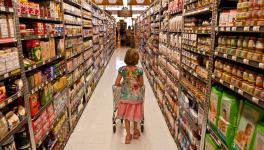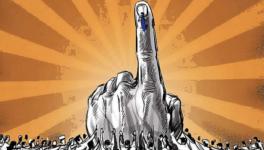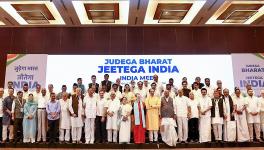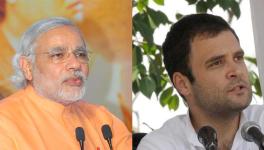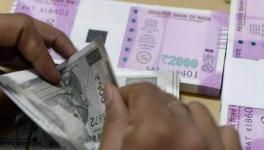Yesterday, the UPA government raised the price of LPG cylinders by Rs 50, the price of diesel by Rs 3 and price of kerosene by Rs 2. This is the umpteenth time since the government of the 'aam admi' has increased the prices of essential commodities for the common people. This huge increase in the prices of essential commodities comes in the backdrop of a situation where the inflation rate of the country is very high.
On the week ending 11th June 2011, the inflation rate for primary commodities was 12.62%, while that of food articles was 9.13%. The inflation rate for fuel and power is 12.84%, within which the inflation rate for LPG is 11.31%, petrol 33.23% and high speed diesel 5.64%. The current hike in the above-mentioned commodities is sure to further increase the inflation rate of the economy, thereby causing even more misery for the people.
The inflation rate of the economy as a whole has been consistently high over the last two years. Even if we look at the figures for this year, we will find that in December 2010, the inflation rate (WPI) was 9.45%, which increased to 9.68% in March 2011 and subsequently declined to 9.06% in May 2011. If we look at week-on-week inflation rate, then also it is seen that the inflation rate for primary products which was 10.94% on 7th May 2011 has increased to 12.62% on 11 June 2011. In this period while the inflation rate remained more than 9%, the government of India increased the price of petroleum products twice in two months. High inflation and the incapacity of the government to deal with it is a major problem in today's Indian economy. Far from dealing with the problem, the government with these measures is further accentuating it.
The government's response on the issue of inflation is two fold. The first argument from the government about the inflationary episode in India, is that the global inflation of food prices has had an adverse impact on the food inflation in India. It is undoubtedly the case that there is an international inflation of food prices, which is sure to have some adverse effect on the food inflation in India. However, this volatility in the world food market is impacting India mainly because of opening up Indian agriculture to the international market, a policy which is aggressively advocated by the government. Now to blame international food inflation for higher inflation in India, must logically result in a rethink of the policies of globalization, which is vehemently ruled out by the government. The fact of the matter is that the government is only saying a half truth. If we look at the following table, it is obvious that the inflation rate in India is the highest amongst major developing countries, except Russia. This shows that putting the blame of higher inflation on international factors is plain wrong.
Table 1: Inflation Rate according to Consumer Price Index (CPI) in Selected Countries
|
Country
|
Inflation Rate (CPI), March 2011
|
|
Brazil
|
6.3
|
|
India
|
8.8
|
|
China
|
5.4
|
|
Indonesia
|
6.7
|
|
Russia
|
9.4
|
|
South Africa
|
4.1
|
Source: RBI Bulletin, May 2011
The main factors driving the food inflation in the economy is basically a prolonged neglect of Indian agriculture, whereby the growth rate of agriculture has come down, so much so that the growth rate of food grains during 1993-94 to 2003-04 was only 0.69% which further reduced to 0.32% during 2004-05 to 2009-10. Such a slowdown in the growth rate of food grain production, is a result of two decades of following neo-liberal policies of decreasing public investment in agriculture, a drying up of agricultural credit, withdrawal of extension services of the government, etc. It is this decline in the production of food-grains which is the real driving force of the inflationary tendencies in the economy. This tendency is further strengthened by speculation through forward trading in food-grains and liberalization of the agricultural sector to world price fluctuations. In other words, the prevailing high food inflation in India is a structural problem and hence will continue unless these problems are overcome.
The other issue with regard to inflation, as repeatedly pointed out by the government is the issue of higher crude prices in the international market, because of which it has to increase the domestic prices of petroleum products. Again, it is true that there has been an increase in the prices of crude oil in the international market. But to deregulate the prices of petroleum products was incorrect for at least two reasons. First, any increase in the international price of oil is basically like a tax levied on the domestic economy by outsiders. The government does not want this extra levy to be imposed on the country. This can be done by keeping the import bill constant, through a reduction in the demand of oil. The price of petroleum products is increased, assuming that the demand for oil is a negative function of price. This is however not the case because oil being a necessary commodity of immense importance, the demand for oil is price inelastic. What essentially results with increasing the price of oil is cost-push inflation, which further adds to the already existing inflationary situation in the country. Moreover, the victims of such inflation are those whose wages do not rise with a rise in inflation, who are essentially the unorganized workers and the poor. In other words, the marginalized section of the poor becomes adversely affected. Thus with price deregulation, neither will the import bill of the government decrease, nor will it lead to any decrease in inflationary pressures. Secondly, the entire argument of under-recoveries of the oil-companies because of which the prices are increased is again a lie. The fact of the matter is that the total revenue collected from the government in 2008-09 from petroleum sector is Rs 161798 crore, while the total subsidy and under-recovery from this sector was Rs 105980 crore, which is less than the total revenue collected.
Faced with such inflationary trends in the economy, the RBI has been raising interest rates, through an increase in the repo rate (the rate at which banks borrow from the RBI), with the hope that this will result in a decrease in demand in the economy, which will result in a decrease in inflationary trends. Even in June 2011, the repo rate was increased from 7.25% to 7.5%, with the explicit aim of reigning in inflation. The question is whether such monetary policy measures will result in a decline in inflation or not.
The basic idea behind increasing the repo rate is that with such an increase, the banks will increase their rate of interest which will result in a decline in investment, demand for real estate and other such loans, thereby decreasing demand in the economy and hence inflation. This is however not a correct assumption to make in case of the current inflationary episode in India. The main ingredients of the current inflationary situation are food inflation and primary commodities inflation, and fuel and power inflation. Now, the problem with food inflation, as has been already discussed is that it is a structural problem resulting from a decline in food-grains production. Secondly, most of the people of the country do not buy food by taking loans from banks. Hence, with increase in interest rate, neither is there a positive impact on food production nor is there an impact on food consumption, since the demand for food is independent of interest rate. On the other hand, the rise in inflation for fuel and power has been mainly administered by the government through raising the price of oil and gas. Any increase in the interest rate does not decrease the price of oil, since it is mainly administered.
Let us however try and look at the macroeconomics of India to look at a more serious problem. The output of any economy can be written in the following form:
Y=C+I+G+X-M
where, C=consumption
I=Investment
G=Government Expenditure, net of taxes
X=Exports
M=Imports
Y=Output
Now, with the policies of neo-liberalism fiscal deficit cannot increase. Hence G does not rise. If we look at the external sector of India, we find that India runs a current account deficit such that (X-M) is negative. With a rise in the prices of international crude oil, the import bill of India has increased resulting in a further downward pressure on the current account. However, the export situation of India is not expected to improve drastically in the recent future. Therefore, there is not much that will change in India's current account. Therefore, the impact of G and (X-M) on the output is negative. Therefore, for Y to increase, C and/or I has to increase.
In India, neo-liberalism has also entailed an increase in inequality with the income distribution tilting towards the rich and elite. With such a pro-rich tilt in income distribution, the growth rate should have had a tendency to come down, since the consumption propensity of the rich is less than that of the poor. However, this did not happen because the growth rate of the economy was mainly sustained by a high consumption of the rich and the elites. This consumption was happening as a result of sections of the Indian middle class gaining from the policies of reforms and also because cheap credit was available for meeting one's consumption expenditure. Moreover, with the policies of liberalization, newer commodities produced in the advanced capitalist economies were introduced in the market, which the rich wanted to buy and consume. The consumption demand of these commodities having a higher level of technological progress resulted in a higher investment which again propelled the growth rate of the economy, given that G and (X-M) had no discernible change. Now, if interest rate rises, not only is the investment affected but also the consumption demand of the rich gets adversely affected, since credit become costly. If this phenomenon continues over a considerable period, in the absence of any other stimulus to growth, like government expenditure or higher net exports, the growth story of India can falter.
This is again no mere conjecture. If we look at the growth rate of industry in the recent past in India, then it is seen that already the growth rate of industrial output has declined substantially. The growth rate of industrial production in April 2010 was 13.5%, which has now come down to 6.3% in April 2011. This decline in the growth rate of industrial production has taken place across every industry as shown in the following table. Most importantly, the slowdown in the growth rate of capital goods industry, consumer goods industry and infrastructure industry is a matter of worry.
Table 2: Growth Rate of Industry (in %)
|
Industry
|
April 2010 Growth Rate
|
April 2011 Growth Rate
|
|
Mining
|
9.2
|
2.2
|
|
Manufacturing
|
14.4
|
6.9
|
|
Electricity
|
6.6
|
6.4
|
|
Basic Goods
|
6.7
|
7.3
|
|
Capital Goods
|
35.5
|
14.5
|
|
Intermediate Goods
|
11.9
|
3.4
|
|
Consumer Goods
|
13.8
|
2.9
|
|
Core Infrastructure Industries
|
7.5
|
5.2
|
Source: Monthly Economic Report, May 2011, Ministry of Finance, Government of India
It is not the case that we are isolating the month of April to show that there has been a slowdown in the growth rate of industrial output in the economy. Rather, this process of slowdown of industrial output is persisting for sometime now. This is shown in the following table:
Table 3: Quarterly Growth Rate of Industry (in %)
|
|
Q4 (2009-10)
|
Q1 (2010-11)
|
Q2 (2010-11)
|
Q3 (2010-11)
|
Q4 (2010-11)
|
|
Industry
|
12.4
|
10.2
|
8.4
|
7.1
|
6.1
|
|
Mining
|
8.9
|
7.1
|
8.2
|
6.9
|
1.7
|
|
Manufacturing
|
15.2
|
12.7
|
10
|
6
|
5.5
|
|
Electricity
|
7.3
|
5.6
|
2.8
|
6.4
|
7.8
|
|
Construction
|
9.2
|
7.7
|
6.7
|
9.7
|
8.2
|
Source: Monthly Economic Report, May 2011, Ministry of Finance, Government of India
It is seen from the above table that the slowdown in the manufacturing growth rate is continuing over 5 quarters while the other industrial sectors have behaved more or less in the same manner during this time period. In other words, there is a problem of slowdown in manufacturing and industry in India.
Even the service sector growth rate has come down over the last five quarters (Table 4). Within the service sector, the only sub-sector which has shown an increase in the growth rate over the last 5 quarters is finance, real estate and business services. The expansion of this sub-sector of finance, real estate etc essentially shows the effect of a credit demand generated bubble in the real estate and other financial sectors. Moreover, this sector has very little capacity to employ people.
Table 4: Quarterly Growth Rate of Services (in %)
|
|
Q4 (2009-10)
|
Q1 (2010-11)
|
Q2 (2010-11)
|
Q3 (2010-11)
|
Q4 (2010-11)
|
|
Services
|
10.2
|
10.7
|
9.9
|
8.4
|
8.7
|
|
Trade, Hotel etc
|
13.7
|
12.6
|
10.9
|
8.6
|
9.3
|
|
Finance, real estate, etc
|
6.3
|
9.8
|
10
|
10.8
|
9
|
|
Community services etc
|
8.3
|
8.2
|
7.9
|
5.1
|
7
|
Source: Monthly Economic Report, May 2011, Ministry of Finance, Government of India
The above-mentioned discussion therefore shows that the economy of India in the current juncture faces two sets of problems. Firstly, there is a persistent problem of inflation in the economy. Secondly, the growth of the economy and its various sectors are also getting adversely affected. The main reason for both the problems is the pursuance of neo-liberal growth trajectory by successive governments in the centre. With the pursuance of these set of policies, agriculture has been adversely affected leading to a rise in food inflation. On the other hand, with these policies being pursued, the only stimulus for growth can come from the consumption of the rich, since the government is committed to maintaining a low fiscal deficit-GDP ratio, and exports not being able to outcompete other players in the world market. If the demand of the rich gets adversely affected, then so does the growth rate.
However, it must be mentioned that the current problem of the economy does not necessarily mean that the growth story of India is going to plummet in the near future. The growth story of India, is basically a story of a growth led by the consumption of the rich and elite. Therefore, this growth story can be sustained by ensuring that no harm is done to this section of the population. This essentially entails pursuing a policy which favours the rich, in terms of more tax concessions, more incentives to invest in share market and real estate etc. This path however not only bypasses the poor but also harms them, since the demand of the rich entails such concessions from the state which are antithetical to the poor. For example, the demand of the rich for real estate development over vast tracts of land is driving out the poor from their land. The problem however with this growth trajectory is that the problem of inflation will remain unsolved. This ironically will give the neo-liberals even more arguments to attack the poor. For example, the problem of food inflation is being used to open up the retail trade in India to FDI. This will cause unemployment and loss of livelihood for the poor while doing nothing on the inflation issue. But the rich are not bothered about food inflation since their incomes are high enough and rising so that they maintain a high level of consumption. The UPA government in accordance with its class compulsions is also not bothered.
The only alternative available is to throw away the neo-liberal model of growth and adopt a people centric development model. This entails a revitalization of the agricultural sector, undertaking a development strategy aimed at employment generation rather than growth etc. All this can be done only with the presence of pro-people active state intervention. All this however, entails a political struggle to not only defeat this or that government but to mobilize the people on a platform which is explicitly anti-imperialist and anti-neo-liberalism. Only such political struggles can ensure the defeat of neo-liberalism in our country and usher in pro-people development.
Pallavi Chavan has shown that the much touted expansion in agricultural credit has little to do with agriculture, and are mainly concentrated strangely in urban and metropolitan areas. How Rural is India's Agricultural Credit? Pallavi Chavan, The Hindu, August 12, 2010
Analysing the Parikh Committee Report on Pricing of Petroleum Products, by Surya P Sethi, EPW, March 27, 2010











